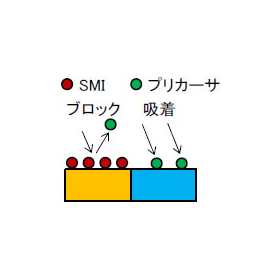X-ray Reflectivity Method
XRR:X-ray Reflectivity
XRR measures the reflection intensity of X-rays incident on the sample surface at a very shallow angle. By comparing the reflection X-ray intensity profile obtained from this measurement with simulation results and optimizing the simulation parameters, this method determines the film thickness and density of the sample. - Evaluation of film thickness is possible (approximately 2 to 300 nm) - Evaluation of density is possible - Evaluation of surface roughness is possible (Rms ≤ 5 nm) - Non-destructive analysis is possible - Average information over a wide area of approximately 10×20 mm can be obtained
basic information
The "critical angle (θc)" refers to the smallest angle of incidence at which total internal reflection occurs when light travels from a medium with a higher refractive index to one with a lower refractive index. When X-rays are incident on a sample at a very shallow angle, if the angle of incidence is smaller than the critical angle, all the incident X-rays are reflected (total reflection). As the angle of incidence is gradually increased, when it becomes larger than the critical angle, the X-rays penetrate the thin film, and the intensity of the reflected X-rays decreases. Further increasing the angle of incidence causes the X-rays reflected from the surface of the thin film and those reflected from each interface to interfere with each other, resulting in an observed oscillation profile. The oscillation profile of the reflectivity obtained in this way corresponds to a specific profile based on the material's d: film thickness, ρ: density, and σ: roughness. By assuming a film structure and conducting simulations, we evaluate the film thickness, density, and roughness by optimizing each parameter so that the measured values match the simulation results.
Price information
-
Delivery Time
Applications/Examples of results
- Evaluation of film density of thin films and film thickness (Evaluation of film density and film thickness for Si oxide films, Low-k films, magnetic materials, metal films, organic EL, amorphous films, etc.) - Evaluation of film density of stacked films - Evaluation of density and film thickness of interface layers
Detailed information
-

Please consult with us first. ★ We will start with a proposal for the analysis plan ★ Meetings at your company are, of course, possible. We will carefully explain the analysis results and leave no questions unanswered. Please contact us at 03-3749-2525 or info@mst.or.jp!
-

We will hold a visiting seminar. ★ We offer free seminars with engineers tailored to our customers' needs ★ Depending on your requests, we will introduce analysis techniques and explain analysis data. ◆ Example seminar content - A broad explanation of MST analysis methods - A detailed explanation of specific analysis methods from the principles - Explanation of the analysis data requested by the customer Please contact us at 03-3749-2525 or info@mst.or.jp!
Recommended products
Distributors
MST is a foundation that provides contract analysis services. We possess various analytical instruments such as TEM, SIMS, and XRD to meet your analysis needs. Our knowledgeable sales representatives will propose appropriate analysis plans. We are also available for consultations at your company, of course. We have obtained ISO 9001 and ISO 27001 certifications. Please feel free to consult us for product development, identifying causes of defects, and patent investigations! MST will guide you to solutions for your "troubles"!



















































